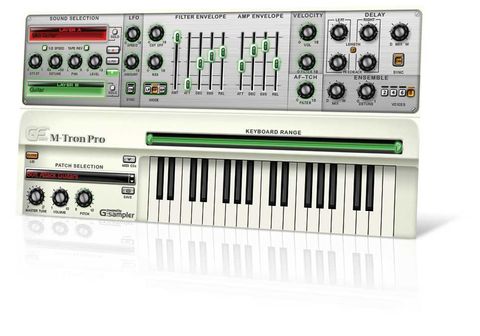Following on from the success of Virtual String Machine, GForce software has updated its venerable M-Tron instrument, the most obvious improvement being that it now uses the same G:sampler interface/engine as VSM.
This has allowed the company to improve overall playback and synthesis options, but it's also remastered and extended the existing library.
The tape bank count now stands at over 200, stacking up to around 3.5GB of content. This includes not only the original M-Tron tape banks (remastered at Abbey Road), but also a host of extras from Chamberlin, Birotron and Optigan. However, there are also over 700 patches, including a bank from renowned 'Tron users.
Where the original software was pretty much a faithful emulation of the Mellotron, the transfer to the G:sampler gives the original content a massive boost.
Most fundamental is the two-layer system. This enables you to blend two source tape banks, with individual or linked control over many parameters. With the majority of controls following a straightforward colour-coded system - red for layer A, green for layer B and blue when they're linked - the interface is extremely easy to use.
Beyond the layer-specific parameters, you'll also find a global effects section. This includes stereo syncable delay and the classic ensemble effect (2, 4, 6 and 8 voice). Finally, rounding things off at a global level are pitch fine-tune, global pitchbend limit, volume and MIDI controller assignment for most parameters.
M-Tron Pro also has a number of 'Tron-specific features. First up, for individual layers, in addition to level, pan and tuning, you can instantly switch 'tape' playback to both half speed and reverse. To tie in with the second option there's also an adjustable start point (attack), enabling you to shift samples forward by up to two seconds in the loop.
The sounds in M-Tron Pro are pretty much as they are on the original source instrument, so each note is individually sampled and key ranges are limited (eg, 35 notes for a Mellotron). One area in which GForce has deviated slightly is looping, with some of the one-shot originals now available in looped format.
Sound and summary
M-Tron Pro ticks all the right boxes sonically. From the instantly recognisable Strawberry Fields flute to the crazy bossa nova set from the Optigan, it offers a stunning array of sounds.
Some of these are presented warts and all (including drop-outs and pitch wobble) and others are bizarrely cheesy. But they all have the kind of character often lacking from modern synth sounds.
However, what takes M-Tron Pro beyond these basic mono building blocks is the G:sampler engine. The ability to layer, pan and shift the timing of the basic sounds brings them smack-bang up to date, and many of the patches show this technology off.
We were very impressed by Virtual String Machine, but M-Tron Pro is even better - if you're a 'Tron guy', don't miss out!


